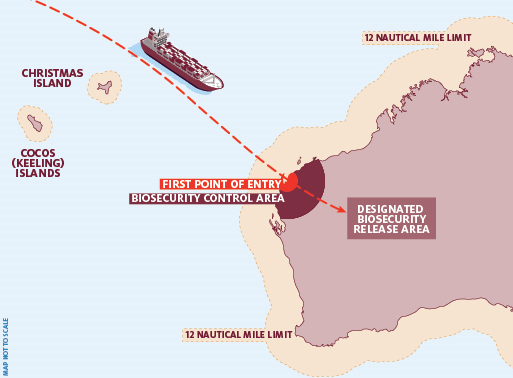The Biosecurity Act 2015 (the Biosecurity Act) explains how we manage biosecurity threats to plant, animal and human health in Australia and its external territories.
We manage biosecurity to ensure a very low level of risk. This draws a balance between protecting Australia from pests and diseases, and maintaining our ability to trade internationally.
The Biosecurity Act has been designed to be flexible and responsive to changes in technology and biosecurity challenges. Being able to adapt quickly is important as international passenger travel and trade are growing and evolving every year.
It also emphasises shared responsibility. Many biosecurity management functions are administered by the Australia Government, but State and Territory governments, industry and the community also have a role to play. By working together we ensure Australia will have an efficient and sustainable biosecurity system into the future.
Learn more about the Act through the Biosecurity Act Interactive Learning tool.
You can subscribe for updates about changes to the biosecurity legislation through our subscription centre.
[Expand all]
Your obligations
You will find information across this website about how to meet your obligations including:
- Travelling or sending goods to Australia
- Importing goods into Australia and Norfolk Island, Christmas Island and the Cocos (Keeling) Islands
- Moving goods to, from and within Torres Strait
- Ballast water management
- Requirements for aircraft, vessels and military
- Applying for and operating under an approved arrangement with the department
If you do not agree with our decisions
Certain decisions we make under section 574 of the Act are reviewable.
Find out more about reviewable decisions and how to request an internal review.
About our biosecurity legislation
The Act is supported by a variety of regulations, determinations and other legal instruments.
You can subscribe for updates about changes to the biosecurity legislation through our subscription centre.
How we administer the Act
Read about our approach to compliance including our general practice administration statements which provide additional guidance on the operation, administration and interpretation of the Biosecurity Act and its provisions.
Where and when the Act applies
The Biosecurity Act applies to Australia, and its external territories including Norfolk Island, Christmas Island, and the Cocos (Keeling) Islands.
Goods and conveyances travelling to Australia are subject to biosecurity control as soon as they enter Australian airspace or the coastal sea of these areas which generally extends 12 nautical miles (NM) from the coast.

Biosecurity and human health zones
The Biosecurity Act 2015 allows the Director of Biosecurity to establish biosecurity zones within Australia to monitor, control and respond to pests and diseases.
Monitoring zones
When a pest or disease that poses an unacceptable level of biosecurity risk enters, emerges or establishes (or is likely to) in Australia, monitoring zones can be established. Biosecurity officers have the power to monitor, control and respond to biosecurity risks within the boundaries of the zone. They typically conduct activities like setting traps and installing monitoring equipment within the zone.
Permanent biosecurity monitoring zones apply 400m beyond the boundary of:
- first points of entry for aircraft, vessels and goods
- international mail centres
- biosecurity activity zones
- other places as prescribed in Biosecurity Regulation 2016 such as the Torres Strait.
Temporary biosecurity monitoring zones can be declared to ensure a risk has not spread. When this occurs the department works with state and territory bodes responsible for biosecurity management in establishing the zone and responding to the threat.
Activity zones
Biosecurity activity zones can be established in Australian territory where a high biosecurity risk associated with people, goods and conveyances moving in and out of the area exists. An example is the Post entry quarantine facility at Mickleham where plants and animals are monitored for exotic diseases and illness after arriving from overseas. Like monitoring zones, activity zones are established in consultation with state and territory bodies responsible for biosecurity management.
Response zones
When a biosecurity officer has reasonable grounds for suspecting that a pest or disease is present on goods, or in a premises, and that they pose an unacceptable risk to Australia’s biosecurity, a biosecurity response zone may be established.
State and territory governments have the primary responsibility for responses within their boundaries, although the Biosecurity Act does allow for the Department of Agriculture, Fisheries and Forestry to engage in response activities.
Human health response zones
The Director of Human Biosecurity may establish a human health response zone if it is necessary for purposes of preventing, or reducing the risk of, a listed human disease emerging, establishing or spreading in Australia or its territories.
The Department of Health has policy and operational carriage of this power, however biosecurity officers have the power to ask questions and/or require written information to be provided by individuals within a human biosecurity response zone.
Biosecurity emergencies
The Governor-General can declare a biosecurity emergency when the Agriculture Minister is satisfied a disease or pest poses a severe and immediate threat or harm on a nationally significant scale to animal or plant health, the environment or related economic activities.
Emergency powers will only be used in limited circumstances to manage biosecurity risk on a nationally significant scale:
- where the response exceeds the capability of state, territory and Commonwealth powers
- where a rapid, nationally consistent response is required to manage a severe and immediate threat.
- During a biosecurity emergency the Agriculture Minister may decide to put in place requirements to prevent or control the establishment or spread of the disease or pest.
Requirements may include:
- specifying entry and exit conditions for people, goods and conveyances
- restricting movement between specified places
- evacuation or removal of goods from specified places
- treatment or destruction of goods
- a direction not to move/interfere with or deal with goods or conveyances.
- closing or restricting access to a premises.
The details of the requirements will depend on the nature and scale of the biosecurity risk associated with the disease or pest, and its location within Australian territory.
